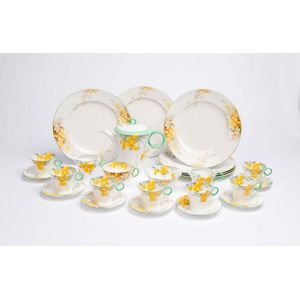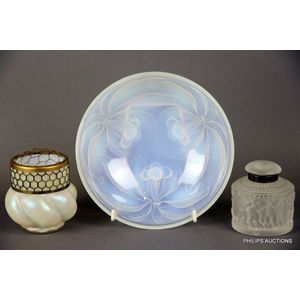1930s Lalique, Kralik, and G. Vallon Glass Collection
You must be a subscriber, and be logged in to view price and dealer details.
Subscribe Now to view actual auction price for this item
When you subscribe, you have the option of setting the currency in which to display prices to $Au, $US, $NZ or Stg.
- Mother-Of-Pearl - Mother-of-pearl, technical name "nacre", is the inner layer of a sea shell. The iridescent colours and strength of this material were widely used in the nineteenth century as an inlay in jewellery, furniture, (especially papier mache furniture) and musical instruments.
In the early 1900s it was used to make pearl buttons. Mother-of-pearl is a soft material that is easily cut or engraved.
Nowadays it is a by-product of the oyster, freshwater pearl mussel and abalone industries. - Circa - A Latin term meaning 'about', often used in the antique trade to give an approximate date for the piece, usually considered to be five years on either side of the circa year. Thus, circa 1900 means the piece was made about 1900, probably between 1895 and 1905. The expression is sometimes abbreviated to c.1900.
- Opalescent / Opaline - The descriptions of glass as "opalescent" or "opaline" are often used interchangeably by dealers and auction houses. At the upper end of the scale, opalescent / opaline glass can refer to the opal-like milky blue glass produced by Lalique and Etling. It also refers to the pressed glass mass produced in Britain from the 1840s with a milky white edge as sugar-basins, milk jugs and vases were made in great quantities for the mass market, and were sold at fairs along with Staffordshire figures and wooden dolls. A less common type of opalescent glass was made from two layers of glass blown into a mould.
This item has been included into following indexes:
Visually similar items

Shelley porcelain Wattle pattern Art Deco tea ware and dinner ware, English circa 1920's, comprising teapot, 2 jugs, sugar bowl, 7 cups and saucers, large cup and 6 dinner plates

Four Shelley tea cup, saucer & plate sets

Pair of Chinese Qianlong porcelain wine cups and saucers, decorated with water birds perched upon rocky outcrops and flowers, in tones of turquoise, yellow and green, with original gallery label, height 4.5 cm (4). Purchased: Geoffrey Waters, London

A forty six piece part Limoges Wg & Co porcelain dinner service, 20th century, with borders of apple green foliage with pink and white roses, comprising: ten dinner and entree plates, eight soup bowls, six side plates, six platters of various sizes, three
